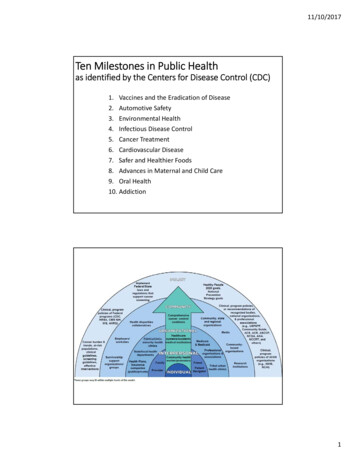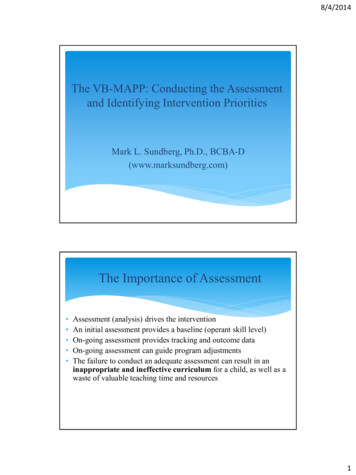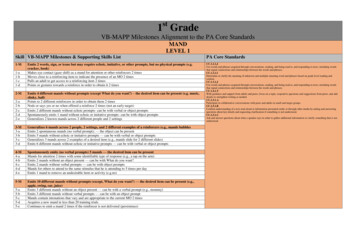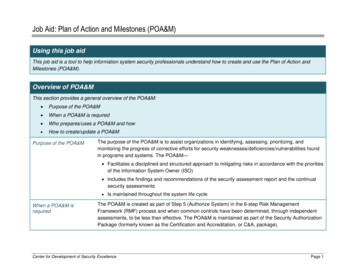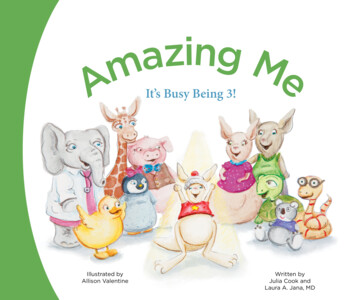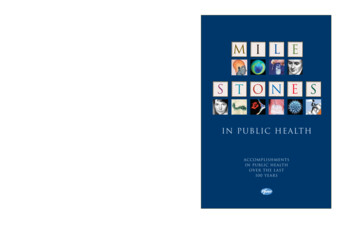
Transcription
M IL E S T O N E S IN PUBLIC HEALTHM IL ES T O N E SIN PUBLIC HEALTHACcOMPLISHmENTSIN PUBLIC HEALTHOVER THE LAST100 YEARS
MILESTONES IN PUBLIC HEALTH
Cover photo keyImhotep, regarded in ancient Egypt as the god of medicine (courtesy National Library of Medicine)An image from space showing a hole in the Earth’s ozone layer ( NASA–GSFC-SVS)The bifurcated needle, which simplified the administration of smallpox vaccine ( Creatas)Dr. Edward Jenner, who pioneered the smallpox vaccine ( Bettman/Corbis)Margaret Sanger, an early promoter of family planning ( Bettman/Corbis)The Ebola virus ( Corbis)MRI of cancerous breast tissue ( Howard Sochurek/Corbis)Tooth with protective sealantAn image of the human immunodeficiency virus (HIV) ( Michael Freeman/Corbis)An image from the U.S. Department of Agriculture’s food pyramid (courtesy www.MyPyramid.gov)Milestones in Public Health is published byPfizer Global Pharmaceuticals, Pfizer Inc, New York, NY, 2006 Pfizer Inc. All rights reserved.The contents do not necessarily reflect the views of Pfizer Inc.No part of this publication may be reproduced in any formwithout prior written permission from the publisher.Correspondence should be addressed to:Milestones in Public Health,c/o Senior Medical Director/Group Leader, Pfizer Inc,235 East 42nd Street, New York, NY 10017-5755.ISBN 0-9761815-1-7Printed in Canada.
IN PUBLIC HEALTHACcOMPLISHmENTSIN PUBLIC HEALTHOVER THE LAST100 YEARS
iMilestones . AcknowledgmentsAcknowledgmentsMilestones in Public Health is a journey through the seminalaccomplishments in the field of public health during the20th century, as well as an inquisitive —and hopefully—inspirational look at the next set of challenges facedby our nation’s public health system. It is not intendedto be a textbook or research publication. Rather, it isa general-interest book about public health that shouldappeal to students in any health-related field, as well aspublic health professionals and others with a keen interestin this field. At the same time, I hope, in a very personalway, that this book will engage those with little knowledgeof the field to learn more about it. I know that a book canchange a life’s direction, as I myself entered public healthafter a book awakened my curiosity about the preventionand control of infectious diseases.Readers will note that we have listed all sources by chapterat the end of the book rather than annotating each fact asit appears in the body of the text. This conscious decisionon our part should make the book more readable whileallowing those who would like to pursue particular topicsto find useful references.Milestones in Public Health is the third in a series of bookspublished by Pfizer Inc’s Public Health Group. These booksare a part of our ongoing commitment to public awarenessand understanding of the field of public health. As withour previous publications – Advancing Healthy Populations:The Pfizer Guide to Careers in Public Health and The Facesof Public Health – this book represents the collective effortsof many individuals who have dedicated countless hoursto its development and production. Our sincere thanks goto Dilia Santana and Oscar Perdomo, U.S. Public Health,Pfizer Inc; Ana Rita González, ScD, Sydney Ann Neuhaus,and Nadjha Acosta of Fleishman-Hillard InternationalCommunications; David L. Farren; and Matt Warhaftig ofWarhaftig Associates.Special thanks must also go to our expert reviewers:Myron Allukian, retired from the Boston Health Commission (Oral Health); Susan Baker, Bloomberg School of Public Health, Johns Hopkins University (Automotive Safety);
iiJoseph Califano, Executive Director, CASA, ColumbiaUniversity (Addiction); James Curran, Dean, Rollins Schoolof Public Health, Emory University (Infectious DiseaseControl); D.A. Henderson, Center for Biosecurity, University of Pittsburgh Medical Center and Dean Emeritus, JohnsHopkins University School of Hygiene and Public Health(Vaccines); Richard Jackson, California Department ofHealth Services (Environmental Health); William Keck,Northeastern Ohio Universities College of Medicine(Public Health Infrastructure); Thomas Pearson, School ofMedicine & Dentistry, University of Rochester (Cardiovascular Disease); Allen Rosenfield, Dean, Mailman School ofPublic Health, Columbia University (Maternal and ChildHealth); John A. Seffrin, Executive Director, AmericanCancer Society (Cancer); and Ernest Julian, Director ofFood Protection, Rhode Island Department of Health (FoodSafety). We appreciate as well the contributions of DavidSatcher, former Surgeon General and Interim President,Morehouse College of Medicine.We are especially grateful to Hugh Tilson, School ofPublic Health, University of North Carolina at ChapelHill. Deeply committed to raising the visibility of thepublic health community, Hugh provided importantperspective and insights throughout the developmentof this book. His energy and enthusiasm for our entireseries of books are invaluable and drive us towardcontinued partnership with this special community.Barbara A. DeBuono, MD, MPHNovember 2005
iiiMilestones . ContentsContentsPrologue1With remarks by David Satcher, MD, PhDMorehouse School of Medicine,16th U.S. Surgeon General1.Vaccines and the Eradication of Smallpox5Expert Reviewer: D.A. Henderson, MD, MPHCenter for Biosecurity, University of Pittsburgh;and Dean Emeritus, Bloomberg School of Public Health,Johns Hopkins UniversityLooking BackCase Study: Eradication of SmallpoxVignette: Hib VaccineLooking Ahead: Advances in Vaccine Research2. Automotive Safety59151621Expert Reviewer: Susan Baker, MPHBloomberg School of Public Health,Johns Hopkins UniversityLooking BackCase Study: Development of Seat BeltsVignette: Air BagsLooking Ahead: Advances in AutomobileManufacturing3. Environmental Health2128313337Expert Reviewer: Richard Jackson, MD, MPHDivision of Environmental Health SciencesUniversity of California, School of Public HealthLooking BackCase Study: Lead PoisoningVignette: AsbestosLooking Ahead: Asthma4. Infectious Disease Control3741495159Expert Reviewer: James Curran, MD, MPHRollins School of Public Health, Emory UniversityLooking BackCase Study: HIV/AIDSVignette: Development of PenicillinLooking Ahead: Antibiotic Resistance59657376
iv5. Cancer83Expert Reviewer: John Seffrin, PhDAmerican Cancer SocietyLooking BackCase Study: Screening Tools for Cancer DetectionVignette: Skin Cancer and Sunblock/SPF ProductsLooking Ahead: Genomic Research and Medicine6. Cardiovascular Disease8390100101107Expert Reviewer: Thomas A. Pearson, MD, MPH, PhDUniversity of Rochester School of MedicineLooking BackCase Study: Risk AssessmentVignette: StatinsLooking Ahead: Obesity in Young Populations7. Safer and Healthier Foods108111114116123Expert Reviewer: Ernest Julian, PhDRhode Island Department of HealthLooking BackCase Study: Jack in the Box E. coli OutbreakVignette: Nutrition Labeling on Food PackagingLooking Ahead: How to Ensure a Safe Food Supply8. Advances in Maternal and Child Health123132138142147Expert Reviewer: Allen Rosenfield, MDMailman School of Public Health, Columbia UniversityLooking BackCase Study: Folic AcidVignette: AmniocentesisLooking Ahead: Genetic Screening9. Oral Health147158161163167Expert Reviewer: Myron Allukian, DDS, MPHFormer Director of Oral Health,Boston Public Health CommissionLooking BackCase Study: FluoridationVignette: Dental SealantsLooking Ahead: Oral Diseases, Stilla Neglected Epidemic167176182183
vMilestones . ContentsContents10. Addiction191Expert Reviewer: Joseph A. Califano, Jr.National Center on Addiction andSubstance Abuse, Columbia UniversityLooking BackCase Study: TobaccoVignette: Mothers Against Drunk Driving (MADD)Looking Ahead: Fighting Addictionin Young Women11. U.S. Public Health Infrastructure191199204207213Expert Reviewer: C. William Keck, MD, MPHNortheastern Ohio Universities College of MedicineLooking BackCase Study: The Creation of CDCVignette: Surgeon General’s Report of 1964Looking Ahead: Public Health –A 21st Century PerspectiveEpilogue213222225227233Barbara A. DeBuono, MD, MPHPfizer Inc.References238
Milestones . PrologueProloguePublic health is the art and science of protecting andimproving the health of a community through an organized and systematic effort that includes education, assuranceof the provision of health services and protection of thepublic from exposures that will cause harm. In other words,public health is what we as a society do collectively toassure the conditions in which people can be healthy. Inorder to effectively address challenges to people’s health,public health practice requires an organized and sustainedpopulation-based approach.Milestones in Public Health portrays public health as thevital, critical field it is today in the United States. Eachchapter in the book celebrates an acknowledged milestoneof public health, exploring first its historical developments,followed by an in-depth case study of the milestone and avignette that illustrates another facet of the milestone, andconcluding with a look ahead. The “Looking Ahead” section predicts advances yet to come in each of the broadareas of public health where milestones occurred, andacknowledges the paramount issue of preparedness nowfacing the public health community. The “Looking Ahead”sections may also explore issues of particular concern tothe public health community – such as asthma or obesityin young people – that have yet to be fully resolved oreradicated.What are these milestones? In keeping with the list of tenacknowledged milestones in public health that have beenidentified by the Centers for Disease Control and Prevention, they are advances in addiction, automotive safety, cancer, cardiovascular disease, environmental and occupationalhealth, food safety, infectious disease control, maternaland child health, oral health, and vaccines. To bring it alltogether, the concluding chapter explores how the development of the public health infrastructure in the UnitedStates has contributed greatly to advances in public health,serving as a model for the world.The milestones identified in this book signify the mostsignificant achievements in public health from the last1
2Milestones . Prologuecentury. As you read the chapters, the long, rich historyof public health should come to life. Through the historicaldevelopments, case studies and vignettes, your insights intothe many successes of public health and the challenges thatwere overcome should deepen. Too often we fail to appreciate the way public health, so basic to the overall healthof Americans, improves our daily lives. Public health worksbest when its successes are hidden, forestalling crises beforethe public grows alarmed. This book seeks to shed light onthe underappreciated achievements of public health andto lay claim, in the open, to its vital work. It is timeto celebrate public health.Milestones in Public Health also seeks to reinforce a coretrait of public health, namely that success redefines thechallenge. Whether with cancer, infectious diseases, oralhealth, vaccines, or a host of other areas, advances yet tocome owe their possibility to the hard, focused work ofpublic health professionals today and in preceding decades.For example, in the chapter on vaccines, we learn thatglobal eradication of smallpox finally succeeded in 1977only after an intense, years-long effort led by the WorldHealth Organization in sub-Saharan Africa and South Asia.Currently, public health professionals are overseeing anintense worldwide effort to eradicate polio. Once theysucceed, other debilitating diseases will become targets, andthe hard work of global eradication will continue. Witheach succeeding battle, refinements in the particular skillsand techniques of public health will allow millions moreof the world’s people to benefit from advances that havebenefited the people of the United States.Another example of how success redefines the challengecomes from the chapter on oral health. Each communityin the United States that has fluoridated its water supplydemonstrates a reduction in the rate of dental caries in itsyoung population.Yet, despite compelling evidence, theprocess of fluoridating the nation’s water supply is far fromcomplete. Even as public health experts gather and sharestatistics that demonstrate the good of a particular milestone, the challenge never dissipates.Each case study and vignette in this book examines indepth the complexities of public health, highlighting how
3each milestone contributed so remarkably to the healthof the American public. Furthermore, the lessons learnedfrom these contributions promise to benefit the world’spopulation. For example, in the chapter on infectiousdisease control, the public health response to the AIDSpandemic, which was first identified in 1981, demonstratestruly astounding progress against a disease that was at firstalways fatal and is now often a treatable, chronic condition.Despite this progress, however, the public health community still confronts the threat of a continuing AIDS pandemic, especially in sub-Saharan Africa, and the cold truths ofno vaccine, no cure, and no inexpensive treatment therapies. As with the global eradication of smallpox, progressin fighting an epidemic – whether it is AIDS, dental caries,or polio, in one country or in one county – redefines thechallenge. Always, new aspects of epidemics and new populations around the world await the vital work of the publichealth community.David Satcher, MD, PhD, formerU.S. Surgeon General and currentInterim President of the MorehouseSchool of Medicine in Atlanta,observes, “It is certainly true thatpublic health always faces new challenges. However, embedded withinthese challenges are also new opportunities. It is clear that the focus ofHealthy People 2010 on the qualityof life and on the targeting of disparities in health amongdifferent racial, ethnic and socioeconomic groups, represents both new challenges and new opportunities forpublic health. Public health is challenged to improve communication and to become more visible while developingnew partnerships with and in the communities. Throughthese partnerships, the opportunity to better impact theall-important social determinants of health is real andtremendous.”The fact that public health is often invisible to the societyit serves does not mean that its successes need to be hidden. Milestones in Public Health seeks to highlight how public health is at the core of our nation’s progress and development and, at the same time, at the center of every family
4and community. Milestones in Public Health celebrates innovative solutions to public health challenges and the peopleand institutions that have implemented them. We hope thisbook will inspire new generations to become public healthprofessionals and to hold in their hands the privilege andresponsibility of building new milestones in publichealth.
Milestones . Chapter 1 . Vaccines . Looking BackChapter 1Vaccines and theEradication of SmallpoxLooking Back“ Ring around the rosy / A pocket full of posies / Ashes,ashes / We all fall down!”Who isn’t familiar with this childhood song? Many peoplemight be surprised that this verse from the 1600s refers toan outbreak of the plague that devastated much of westernEurope. Humans are still vulnerable to infectious diseasesthat through history have run rampant and killed vastnumbers of people. The plague and smallpox did just thatthrough much of the Dark and Middle Ages. New virusessuch as HIV and SARS threaten humans in this century.The development of vaccines, therefore, is one of man'sDr. Edward Jennerinoculating a childwith vaccinia virustaken from a cow.greatest achievements.Vaccines protect people from fataldiseases, increase life expectancy and spare countlessmillions from pain and suffering.The word vaccine comes from “vaca,” Latin for cow. In1796 in Gloucestershire, England, Dr. Edward Jenner5
6Milestones . Chapter 1 . Vaccines . Looking Backdiscovered the first vaccine for smallpox. Jenner used material from a skin pustule which contained live vaccinia virus, avirus believed to be spread by cows to milkmaids, causingcowpox. Milkmaids who contracted cowpox, a mild diseasein humans, seemed to be immune to smallpox, a virulentdisease in humans. Jenner inoculated 24 children with thevaccinia virus and, like the milkmaids, they became immuneto smallpox. Despite its success, the smallpox vaccine neverbecame widespread enough to fully control the diseaseuntil late in the 20th century. It was especially problematicin the tropics, where suspensions could not be kept coolenough to be effective.In 1895, Louis Pasteur developed the second vaccine, thisone for rabies, a groundbreaking achievement. As the firstexample of a pathogen being altered for a therapeuticpurpose, Pasteur’s success opened the door to the fieldof immunobiology. That same year, Emil von Behring ofMarburg University in Germany introduced the diphtheriavaccine. Three other vaccines – for typhoid, cholera andplague – were also developed late in the 19th century, buttheir use was not widespread at the beginning of the 20thcentury. Too many impoverished countries had no publichealth infrastructure, and the costs of vaccine distributionwere prohibitive.Louis PasteurAlthough smallpox was still widely prevalent in the UnitedStates at the beginning of the 20th century, it was by nomeans the only infectious disease to affect the Americanpopulation. In 1920, for example, 469,924 cases of measlesresulted in 7,575 deaths. That same year, nearly 148,000diphtheria cases resulted in more than 13,000 deaths and107,473 pertussis cases resulted in more than 5,000 deaths.The development of the polio vaccine in 1955 had aradical impact on the use of vaccines in the United States.Parents were eager to protect their children from the “ironlung” disease, and Congress appropriated funds to inoculateschool children with the polio vaccine. The U.S. governmentthen began a major push to promote the use of vaccines.Today, most Americans don’t think twice about vaccination.Children routinely undergo a series of vaccinations frombirth through early childhood. These include vaccinationsagainst diphtheria, pertussis, tetanus, poliomyelitis, measles,mumps, rubella, chicken pox and Haemophilus influenzae1955 polio vaccination.
7type b (Hib). Some of these vaccines – measles, mumpsand rubella (MMR), for example – have been combinedand can be administered in one dose.Child with the redblotchy pattern ofmeasles.Child being inoculated today.What exactly is a vaccine, and how is it made?A vaccine is formally defined as “a preparation of killed,weakened, or fully infectious microbes that is given toproduce or increase immunity to a particular disease.”It can be given as an injection or in a form that can beswallowed (such as the polio vaccine).Vaccine researchersare inventing other means of safely and effectivelydelivering vaccines, such as nasal sprays.Child with mumpsbefore vaccine wasintroduced in 1967.Vaccines fall into three broad categories: Live (Attenuated) Vaccine. This type of vaccine uses alive, although weakened, version of the virus; it usuallyprovides lifelong immunity to the recipient. Measles,mumps and rubella vaccines are examples of the livevaccine type. Killed (Inactivated) Vaccine. This vaccine uses apathogen exposed to Formalin, a chemical that killsits genetic material, leaving just its shell. This form ofvaccination usually requires several injections. Thetyphoid and Hib vaccines are examples.
8Milestones . Chapter 1 . Vaccines . Looking Back Toxoid Vaccine. This type of vaccine uses protein toxinsthat have been secreted by pathogenic bacteria but areinactivated. These vaccines also require several injections; diphtheria and tetanus vaccines are examples.Since 1900, vaccines have been developed and licensedagainst 21 other diseases, with ten limited to selectedpopulations at high risk according to residence, age,medical condition or risk behaviors. At the start of the21st century, the vaccine-delivery system in the UnitedStates has evolved into a collaboration of all levels ofgovernment (federal, state, local) and public and privatehealth care providers. The system continues to harnessthe latest technological advances.
Milestones . Chapter 1. Vaccines . Case StudyCase StudyEradication of SmallpoxSmallpoxHistorians saythat smallpoxmade the Spanishconquest ofMexico possiblewhen Cortés andhis conquistadorsintroduced it tothe Aztec population in Techotitlanin 1520.The story of vaccines begins with smallpox. Overthousands of years, hundreds of millions of peoplecontracted the disease. The mummified body of PharaohRamesses V of Egypt, who died in 1157 BC, shows apustular rash, the earliest physical evidence of smallpox.During the next thousand years, traders carried the disease from Egypt to India, and from there it swept intoChina. It reached Japan by the 6th century and Europeby the 11th century, spread by returning crusaders. In the20th century alone, an estimated 300 million people arebelieved to have died from it. Although smallpox wasdeclared eradicated in 1980, the threat that it might bedistributed by a terrorist has created fear.Smallpox was particularly contagious and deadly inpopulations exposed for the first time to explorers fromEurope. It paved the way for Spanish conquests in LatinAmerica.Historians say that smallpox made theSpanish conquest of Mexico possible when Cortés andhis conquistadors unintentionally introduced it to the Aztecpopulation in Techotitlan in 1520. Smallpox ravaged theAztecs, who had no natural immunity. Cortés and his menthen proceeded to conquer a vastly weakened Aztecempire. During the French and Indian War, Lord JeffreyAmherst deliberately infected blankets with smallpox anddistributed them to Indians outside Fort Ticonderoga, thefirst known example of germ warfare.Smallpox affects only humans. Transmission occurs whenthe variola virus (an orthopoxvirus) is inhaled in dropletsor aerosols from the respiratory tract. Transmission alsooccurs through contact with skin lesions of infectedpatients or their bedding or clothing. The incubationperiod lasts seven to 17 days, with an average of 12 days.The disease presents first with fever for two to four days,followed by a rash lasting for weeks. The rash evolvesslowly from papules to vesicles, then pustules and finallyscabs, all at the same stage in any one area. Transmission9
10Milestones . Chapter 1 . Vaccines . Case Studyoccurs mainly during the rash phase and diminishes as thelesions scab. Historically, about 50 percent of unvaccinatedfamily members became infected. The mortality rate was20 percent to 30 percent in unvaccinated populations, butmany survivors were left with severe scarring and somewith blindness.Noting that survivors enjoyed lifelong immunity from anyrecurrence of the disease, physicians in China and India inthe 10th century began to experiment with inoculation.In a process called variolation, these physicians introducedpus from smallpox pustules on infected people into noninfected people. Usually, the person who was inoculatedwould develop only a few pustules and a fever. However,in up to two percent of the cases, a virulent or aggressiveform of the disease developed, causing death. Nonetheless,the odds were great that an inoculated person would survive and, thereafter, enjoy lifelong immunity. The idea ofvariolation spread to Europe.In a famous case in1721, Lady Mary Wortley Montagu, a smallpox survivorleft with unsightly pockmarks, learned of variolation whileher husband was posted to Constantinople as the Britishambassador. She inoculated her children and persuadedthe Princess of Wales to do the same. In fact, EdwardJenner, the discoverer of the smallpox vaccine, had beenso inoculated.In 1796, Dr. Jenner vaccinated 24 children with pus hehad extracted from a milkmaid’s cowpox pustule. First,he experimented with James Phipps, an eight-year-oldboy, by introducing the cowpox strain through a cut inthe arm. After purposely exposing the young boy tosmallpox, Jenner followed the boy’s status closely andconcluded that the introduced vaccinia virus conferredimmunity from smallpox. Next, Jenner inoculated hisown 11-month-old son with the same result. The cowpoxvaccine proved effective with all 24 children, conferringlifelong immunity from smallpox. By today’s standards,Jenner’s experiments on human subjects would not beconsidered ethical. Fortunately, the fact that his cowpoxvaccine worked is not in dispute, and his discovery wouldprotect millions of lives in the future.In 1721, smallpoxsurvivor, LadyMontagu, learnedof variolation whilein Constantinople.She inoculatedher children andpersuaded thePrincess of Walesto do the same.
11Smallpox continued to appear in outbreaks throughoutthe world into the 20th century. In fact, a deadly smallpoxoutbreak in the United States between 1900 and 1904caused an average of 48,164 cases in each of those yearsand resulted in an average of 1,528 deaths annually. Dueto improved tracking and containment, outbreaks of thesevere form of the disease (variola major) ended abruptlyin 1929 in the U.S.; outbreaks of variola minor, the milderform, declined in the 1940s with the last U.S. case reported in 1949.One scare in New York City in 1947 resulted in thecity vaccinating more than six million residents. AMexican businessman who traveled by bus to the city,unaware that he was incubating smallpox, spread thedisease to 12 people, two of whom died, including him.New Yorkers line up for inoculation in 1947.Fearing the worst in the densely populated city, healthauthorities took no chances and ordered the mass vaccination, which took place within one month at hundredsof stations in hospitals, police stations and firehouses.A resolution proposed by a delegate from the formerUSSR at the 11th World Health Assembly in 1958 and
12Milestones . Chapter 1 . Vaccines . Case Studypassed by the assembly in 1959 paved the way for aworldwide effort to eradicate smallpox. In 1966 atthe 19th World Health Assembly, the World HealthOrganization (WHO) called upon all the world’s governments to support and give financial backing to a newlycreated Global Smallpox Eradication Campaign.Why did smallpox, of all diseases, become a candidate forworldwide eradication? An important reason was that itremained a powerful killer throughout the world. In theyear prior to the start of the WHO eradication program,an estimated 15 million people contracted the disease andan estimated two million people died from it. Smallpoxlent itself to the possibility of complete eradication forother reasons as well. Only humans are hosts; no animal reservoir exists,so smallpox cannot jump from animals to humans. A prompt antibody response allows exposed peopleto be protected. The vaccine is very inexpensive, easy to administer,does not require refrigeration, and provideslong-term protection. Smallpox has no subclinical infection, or hiddencarrier state, to contend with. The disease is alwaysovert and can, therefore, be traced and contained.World HealthOrganization inGeneva.The Global Smallpox Eradication Campaign became aworldwide public health program like no other. TheWHO chose Donald Ainslie (D.A.) Henderson to headthe campaign. He moved to Geneva, Switzerland, fromAtlanta, where he had headed the CDC’s InfectiousDiseases Surveillance Unit.D.A. Henderson was born in 1928 in Ohio, attendedOberlin College, and graduated from the University ofRochester’s medical school. Immediately after, he joinedthe Epidemic Intelligence Service (EIS) at CDC and continued his career there. His work in containing variousinfectious diseases in the United States and in hot spotsthroughout the world had earned him internationalacclaim. He pioneered improved methods for diseasecontrol that emphasized better reporting of infectiousD.A. Henderson
13diseases so that control measures could begin sooner tocontrol the diseases. This became the most importantstrategy in smallpox eradication – surveillance to detectcases as early as possible and vaccination of all contactsof patients by specialized teams so that the outbreakwould not spread.and the worldbegan to understand that promptdetection andcontainmentcould lead to theeradication of thedisease.In 1967, the campaign got under way using D.A.Henderson’s methods. The WHO worked with healthworkers in all the infected countries to form surveillanceteams ready to track down smallpox outbreaks and armedwith “recognition cards” that explained the disease simply.As the number of smallpox cases decreased, the teamsoffered rewards to encourage reporting. The earliestsuccesses came in western and central Africa. Smallpoxturned out to spread less readily than had previously beenthought,and the world began to understand thatprompt detection and containment could lead to theeradication of the disease. Although the western Africancountries reporting endemic cases at the beginning of thecampaign were among the poorest in the world and hadheavy infection rates, all but one of them became free ofsmallpox within three years. Brazil recorded the last casein the Western Hemisphere in April 1971. Well-executederadication programs eliminated smallpox transmission inEast Pakistan (now Bangladesh) in 1970 and in Indonesiaand Afghanistan in 1972. In eastern and southern Africa,smallpox had been eliminated in all but three countriesby the end of 1971.The introduction of potent, freeze-dried vaccine andthe bifurcated needle had remarkable effects on smallpoxprevalence, even in countries where eradication programsstalled. The freeze-dried version solved the problem ofthe vaccine losing potency in the heat of the tropics. Thebifurcated needle, which was easy to transport, simplifiedadministering the vaccine.The bifurcated needle,which simplified administration of the vaccine.Unfortunately, setbacks did o
to be a textbook or research publication. Rather, it is a general-interest book about public health that should appeal to students in any health-related field, as well as public health professionals and others with a keen interest in this field.At the same time, I hope, in a very perso
